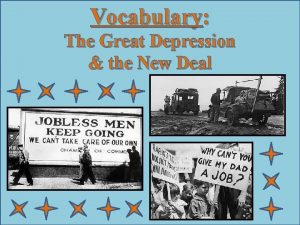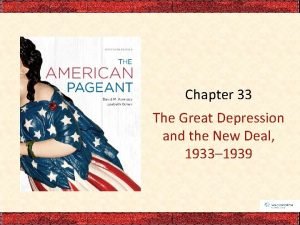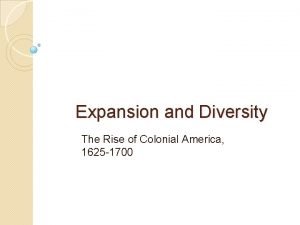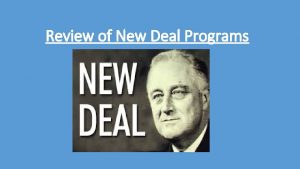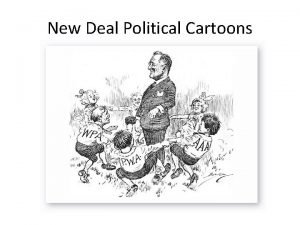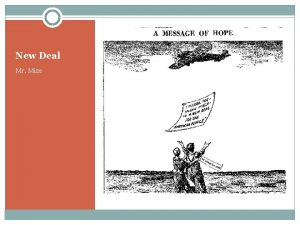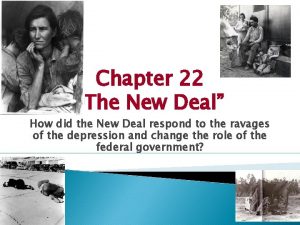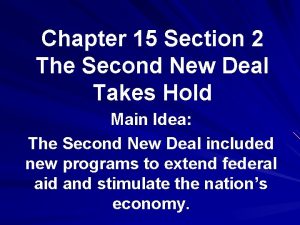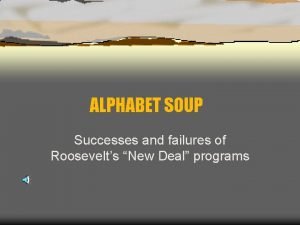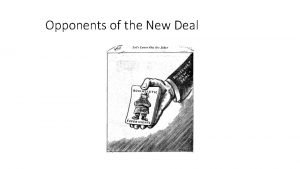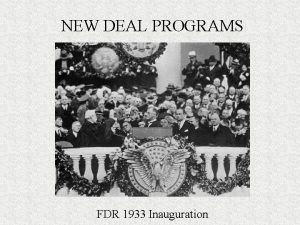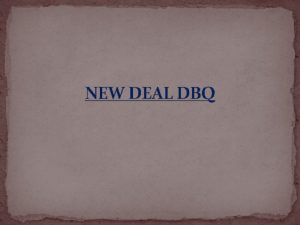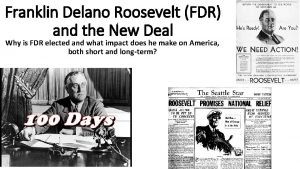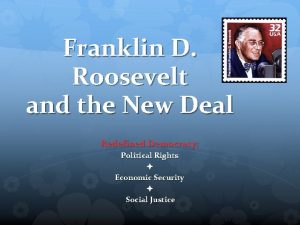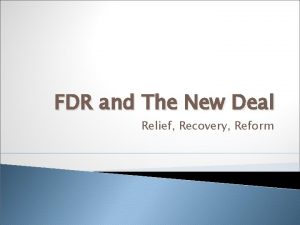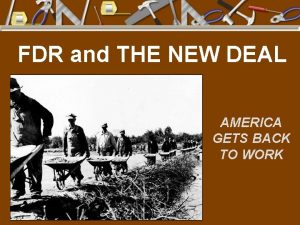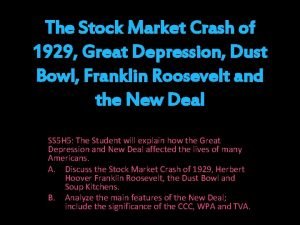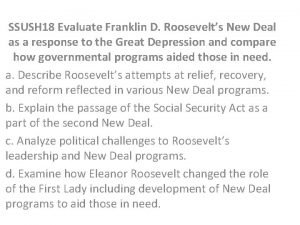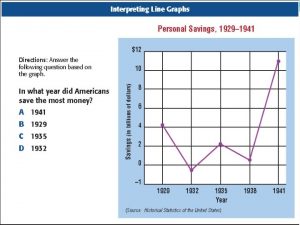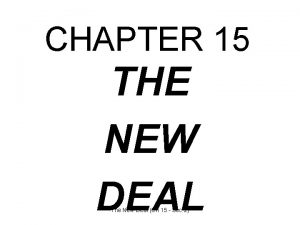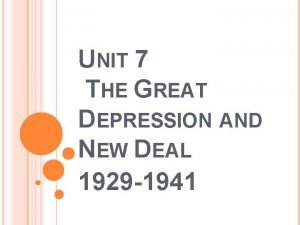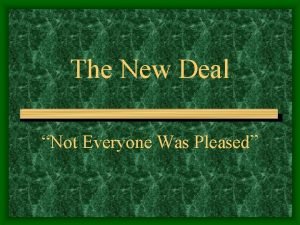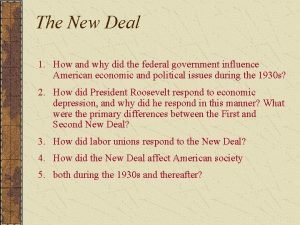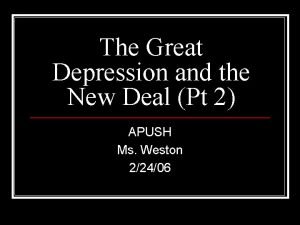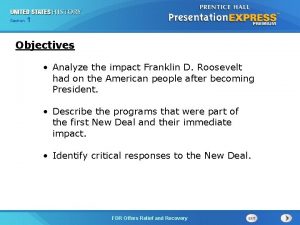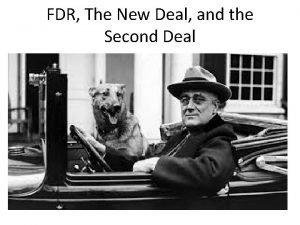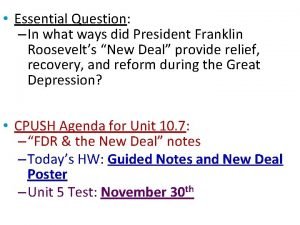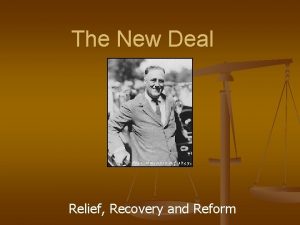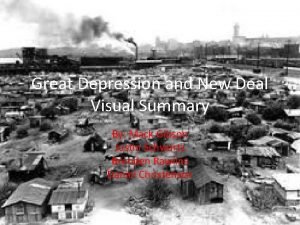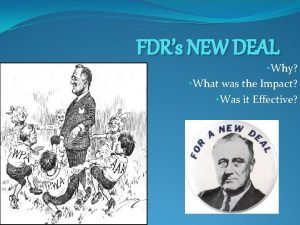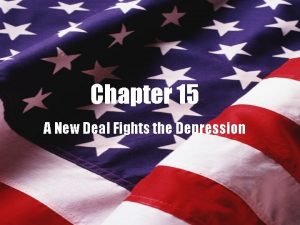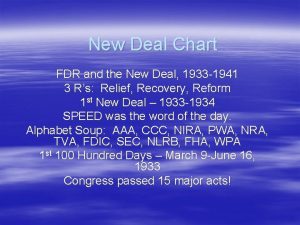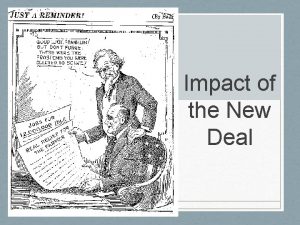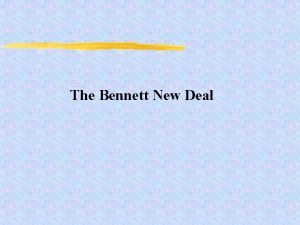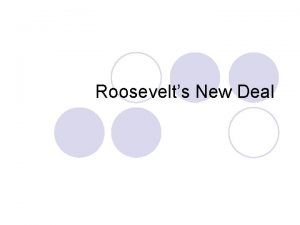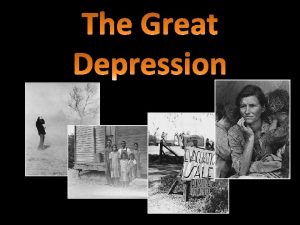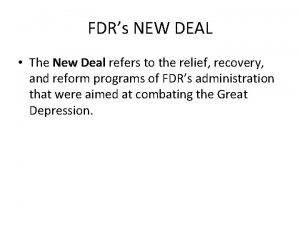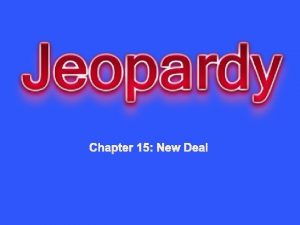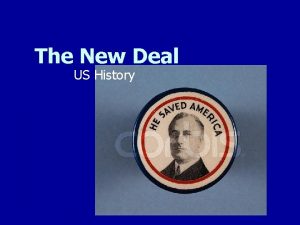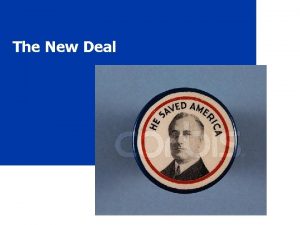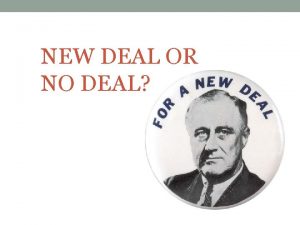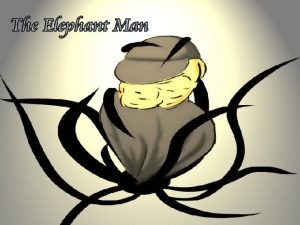The New Deal 1 How and why did




















































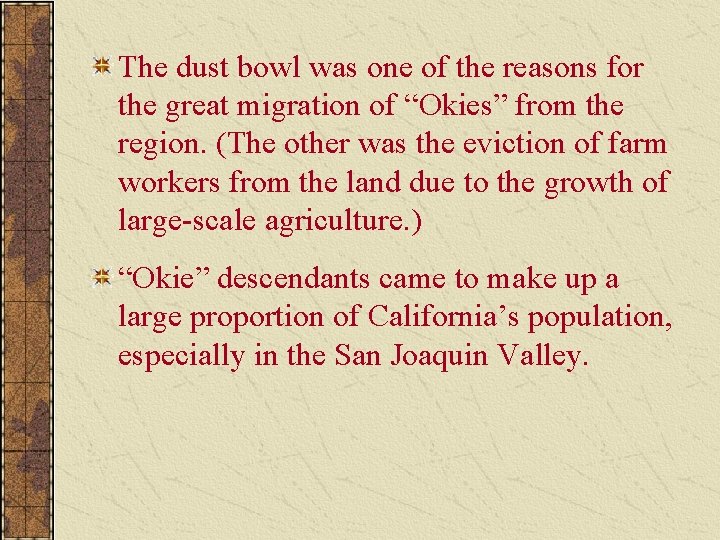
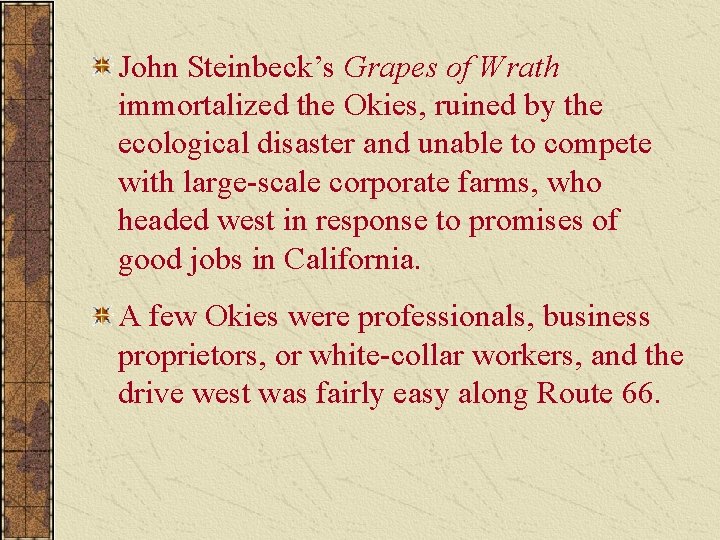
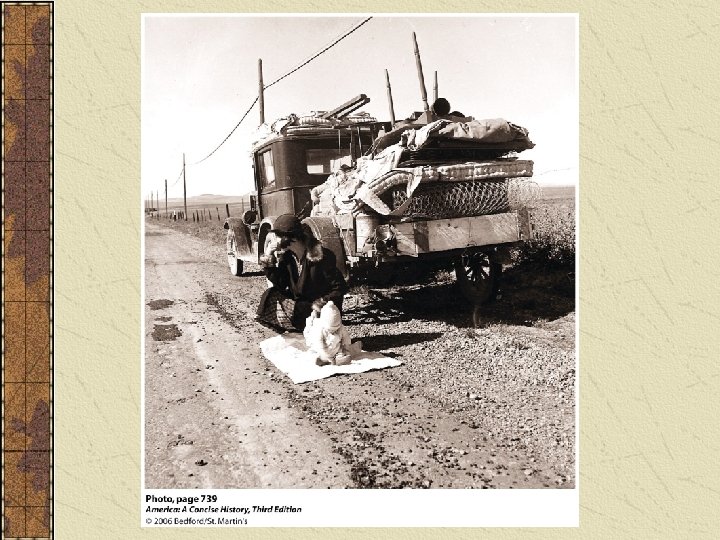


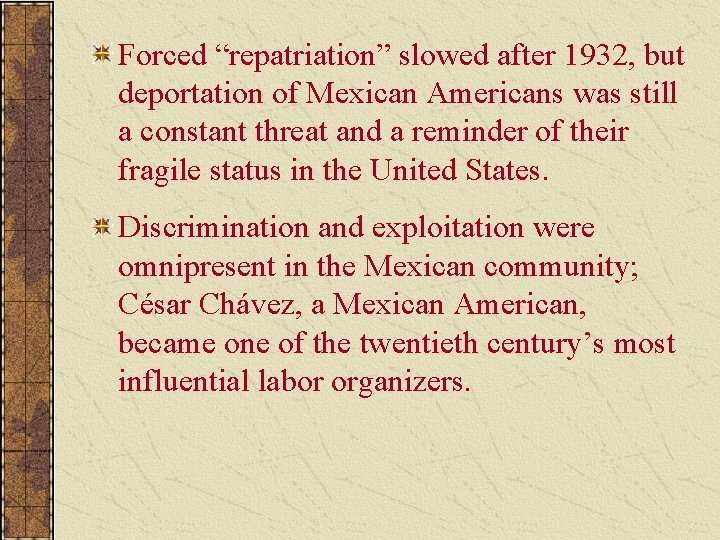

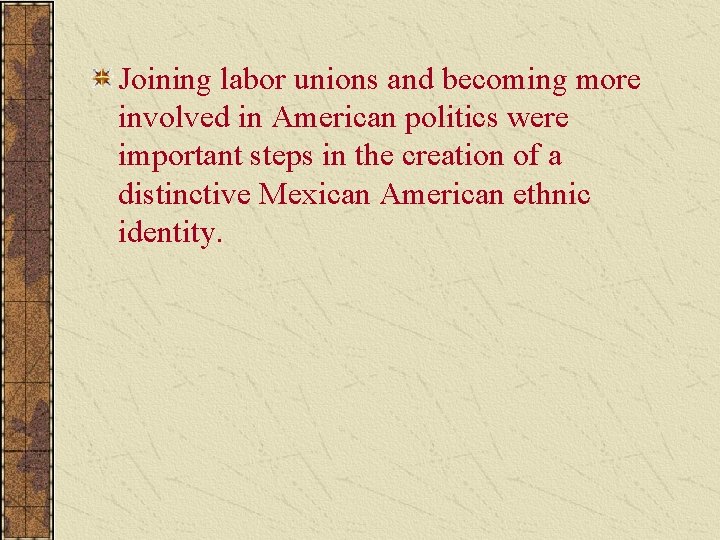
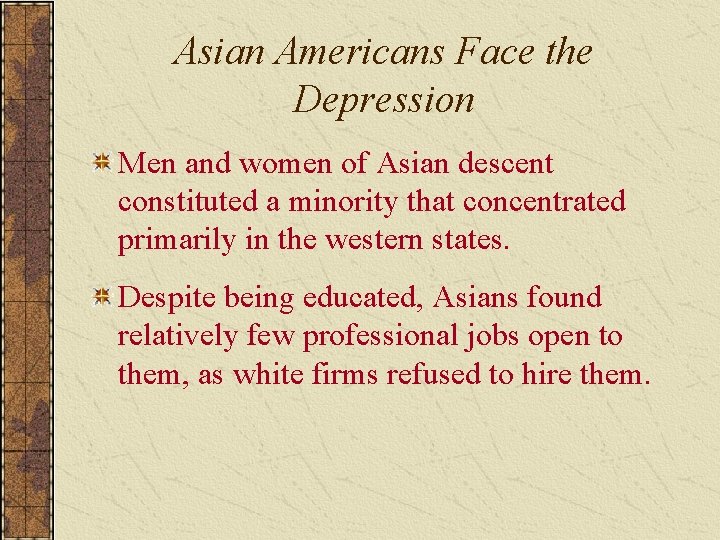
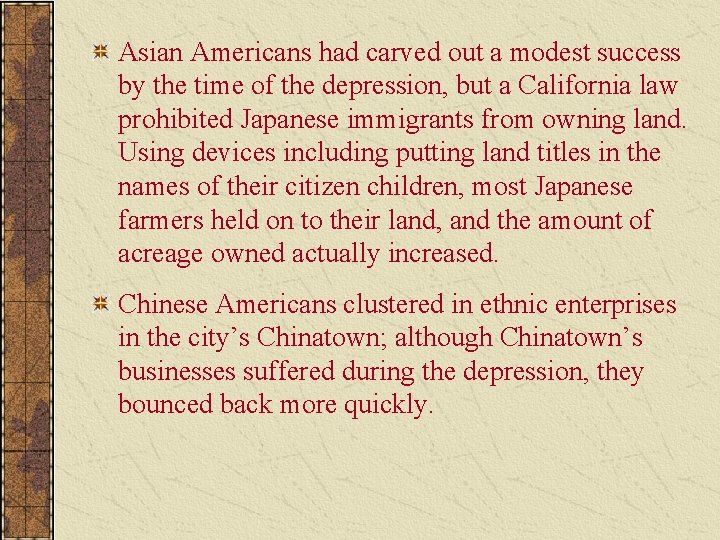
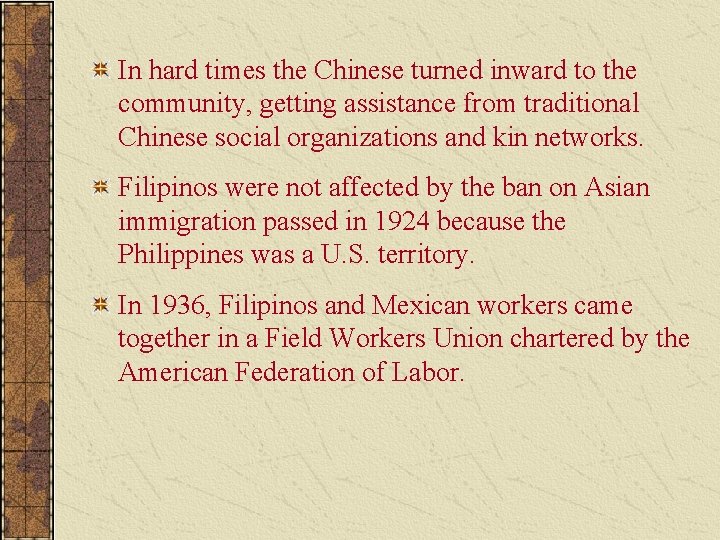
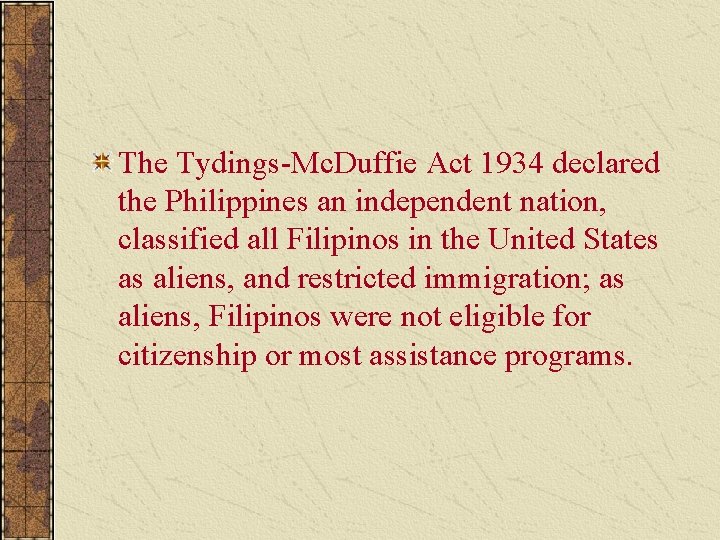
- Slides: 64

The New Deal 1. How and why did the federal government influence American economic and political issues during the 1930 s? 2. How did President Roosevelt respond to economic depression, and why did he respond in this manner? What were the primary differences between the First and Second New Deal? 3. How did labor unions respond to the New Deal? 4. How did the New Deal affect American society 5. both during the 1930 s and thereafter?

The New Deal, 1933– 1939

The 1932 election marked the emergence of a Democratic coalition that would help to shape national politics for the next four decades. In the worst winter of the depression, unemployment stood at 20 to 25 percent, and the nation’s banking system was close to collapse. The depression had totally overwhelmed public welfare institutions, and private charity and public relief reached only a fraction of the needy; hunger haunted both cities and rural areas.

The New Deal came to stand for a complex set of responses to the nation's economic collapse. The New Deal was meant to relieve suffering yet conserve the nation's political and economic institutions. Through unprecedented intervention by the national government, Roosevelt's programs put people to work, instilling hope and restoring the nation's confidence.

The Great Depression destroyed Herbert Hoover's reputation and helped to establish Roosevelt's ideology was not vastly different from Hoover's, but he was willing to experiment with new programs to address the current crisis. His programs put people to work and instilled hope in the future. Roosevelt crafted his administration's programs in response to shifting political and economic conditions rather than according to a set ideology or plan.




Roosevelt made his administration's programs respond to shifting political and economic conditions rather than adhering to a set ideology or plan. He established a close rapport with the American people; his use of radio-broadcasted 'fireside chats' fostered a sense of intimacy. Roosevelt's approach expanded the power of the executive branch to initiate policy, thereby helping to create the modern presidency.

Roosevelt's promise to act quickly was embodied in the legislation of the "hundred days. " Programs were quickly established to aid agriculture and industry, and direct relief was provided to millions of suffering families. Federal job projects aided millions more. Although those actions did not end the depression, they offered both hope and sustenance to many. Legislation regulating banks and the stock market sought to eliminate some of the financial excesses of the 1920 s that had contributed to the depression.

Popular leaders accused the New Deal of moving too slowly in redistributing wealth and caring for the elderly. This pressure from the left caused FDR to inaugurate the "Second New Deal" a program that offered support for organized labor and Social Security legislation that included unemployment insurance and aid to those who couldn't work.

Persistent and pervasive unemployment led to the establishment of the Works Progress Administration (WPA), an agency that would provide millions of federally funded jobs through the remainder of the decade. The New Deal accelerated the expansion of the federal bureaucracy, and power was increasingly centered in the nation's capital, not in the states.

Public Works Projects

During the 1930 s the federal government operated as a broker state, mediating between contending groups seeking power and benefits. After FDR's reelection in 1936, the New Deal began to falter. An abortive attempt to alter the structure of the Supreme Court undercut FDR's popularity, and his premature reductions in federal spending led to the "Roosevelt recession" of 1937 to 1938.

Roosevelt's attempt to "purge" the Democratic Party of some of his most conservative opponents only widened the liberal-conservative rift as the 1938 election approached. Fresh out of ideas and with the nation still in a depression, FDR's basic conservatism became more apparent. Tinkering with the system had not led to economic recovery; something more drastic would be required.

Even though the New Deal did not end the depression, it ushered in an unprecedented expansion of the federal government that redefined its role. By seeking to spread benefits more equitably among neglected portions of the population, the New Deal attracted African Americans, professional women, and organized labor to the Democratic Party.

For the first time, organized labor had federal support, and prominent blacks and women were brought into government service. The New Deal laid the foundation for a modified welfare state and created a political coalition that would dominate national politics for most of the next three decades.

The Great Depression saw a flowering of American culture. The WPA employed many writers and artists to produce works that celebrated the lives of ordinary people throughout the nation. A hallmark of the era was the "documentary impulse, " a presentation in photography, graphic arts, music, and film of a social reality designed to elicit public empathy. As Europe moved toward war and Japan expanded its incursions in the Far East, Roosevelt focused less on domestic reform and more on international relations

The New Deal Takes Over, 1933– 1935 The Roosevelt Style of Leadership The Hundred Days

At the beginning of his administration, Roosevelt convened Congress in a special session and launched the New Deal with an avalanche of bills. Historians refer to this period as the "Hundred Days. " Roosevelt introduced a new notion of the presidency whereby the president, not Congress, was the legislative leader. Most of the bills he proposed set up new government agencies, called the "alphabet soup" agencies because of their array of acronyms.

AAA (Agricultural Adjustment Act)-Designed to help American farmers by stabilizing prices and limiting overproduction, the AAA initiated the first direct subsidies to farmers who did not plant crops. The United States Supreme Court later declared the AAA unconstitutional and an unnecessary invasion of private property rights.

CCC (Civilian Conservation Corps)--A public works project, operated under the control of the army, which was designed to promote environmental conservation while getting young, unemployed men off city street corners. Recruits planted trees, built wildlife shelters, stocked rivers and lakes with fish, and cleared beaches and campgrounds. The CCC housed the young men in tents and barracks, gave them three square meals a day, and paid them a small stipend. The army's experience in managing and training large numbers of civilians would prove invaluable in WWII. Wisconsin was a beneficiary of the CCC; one of the organizations many local projects was trail construction at Devil's Lake State Park.

Civilian Conservation Corps Workers

TVA (Tennessee Valley Authority)--One of the most ambitious and controversial New Deal projects, the TVA proposed building dams and power plants along the Tennessee River to bring electric power to rural areas in seven states. Although the TVA provided many Americans with electricity for the first time and provided jobs to thousands of unemployed construction workers, the program outraged many private power companies.

NIRA (National Industrial Recovery Act)-The NIRA established the NRA (National Recovery Administration) to stimulate production and competition by having American industries set up a series of codes designed to regulate prices, industrial output, and general trade practices. The federal government, in turn, would agree to enforce these codes. In return for their cooperation, federal officials promised to suspend antitrust legislation. Section 7 A of the NIRA recognized the rights of labor to organize and to have collective bargaining with management. The NIRA was the most controversial piece of legislation to come out of the Hundred Days and many of its opponents charged it with being un-American, socialist, even communist, even though it did not violate the sanctity of private property or alter the American wage system.

The National Industrial Recovery Act launched the National Recovery Administration (NRA), which established a system of industrial self-government to handle the problems of overproduction, cutthroat competition, and price instability. The NRA’s codes established prices and production quotas, as well as minimum wages and maximum hours, outlawed child labor, and gave workers union rights. Trade associations, controlled by large companies, tended to dominate the NRA’s code drafting process, thus solidifying the power of large businesses at the expense of smaller ones.

The Federal Emergency Relief Administration (FERA), set up in May 1933 under the direction of Harry Hopkins offered federal money to the states for relief programs and was designed to keep people from starving until other recovery measures took hold. Over the program’s two-year existence, FERA spent $1 billion. Whenever possible New Deal administrators promoted work relief over cash subsidies, and they consistently favored jobs that would not compete directly with the private sector.

Civil Works Administration (CWA) Established in November, 1933, the Civil Works Administration (CWA) put 2. 6 million men and women to work; at its peak, it employed 4 million in public works jobs. The CWA lapsed the next spring after spending all its funds. Many of these early emergency measures were deliberately inflationary and meant to trigger price increases thought necessary to stimulate recovery.

Roosevelt’s executive order of April 18, 1933, to abandon the international gold standard allowed the Federal Reserve System to manipulate the value of the dollar in response to fluctuating economic conditions. In 1934, the Securities and Exchange Commission was established in order to regulate the stock market and prevent abuses. The Banking Act of 1935 placed the control of moneymarket policies at the federal level rather than with regional banks and encouraged centralization of the nation’s banking system.

New Deal Under Attack Business leaders and conservative Democrats formed the Liberty League in 1934 to lobby against the New Deal and its “reckless spending” and “socialist” reforms. In Schechter v. United States, the Supreme Court ruled that the National Industrial Recovery Act represented an unconstitutional delegation of legislative power to the executive branch. Citizens like Francis Townsend thought that the New Deal had not gone far enough; Townsend proposed the Old Age Revolving Pension Plan.

In 1935, Father Charles Coughlin organized the National Union for Social Justice to attack Roosevelt’s New Deal and demand nationalization of the banking system and expansion of the money supply. Because he was Canadian-born and a priest, Coughlin was not likely to run for president —the most direct threat to Roosevelt came from Senator Huey Long. In 1934, Senator Long broke with the New Deal and established his own national movement, the Share Our Wealth Society.

Coughlin and Long offered feeble solutions to the depression and quick-fix plans that addressed only part of problem. Both men showed little respect for the principles of representative government.

Why the NIRA failed Whether radical or conservative, the NIRA ultimately failed for three reasons: – The NRA assumed businesses would police themselves. The codes, established in the interest of protecting workers and consumers, were ultimately drawn up by the largest companies. This hurt small businesses. – Corporations rarely respected the rights of labor to organize. Because of the number and complexity of the codes, the federal government never enforced labor's right to collective bargaining. – The NRA attacked recovery from the wrong direction. It tried to stabilize prices by lowering production, rather than redistributing money to American consumers and encouraging them to purchase goods. Within two years, the Supreme Court declared the NIRA unconstitutional.

"The Broker State" During his first two years in office, FDR promoted a new vision of the executive branch; he viewed himself as an "honest broker" who would negotiate among competing interests. The president would mediate conflicts while balancing the interests of one group against another. His older cousin TR had held a similar idea of the presidency, but FDR expanded this concept of the broker state. However, the idea of the broker state has two inherent flaws:

Presidents tend to get weaker the longer they are in office, because they have to make tough choices that alienate particular interest groups. The strongest interest groups can pressure even the most forceful broker. This was true in FDR's administration, when the NIRA and AAA favored big business and big agriculture

The New Deal accelerated the expansion of the federal bureaucracy, and power was increasingly centered in the nation’s capital, not in the states. During the 1930 s the federal government, then, operated as a broker state, mediating between contending groups seeking power and benefits. After FDR’s reelection in 1936, the New Deal began to falter. An abortive attempt to alter the structure of the Supreme Court undercut FDR’s popularity, and his premature reductions in federal spending led to the “Roosevelt recession” of 1937 to 1938.

Roosevelt’s attempt to “purge” the Democratic Party of some of his most conservative opponents only widened the liberal-conservative rift as the 1938 election approached. Fresh out of ideas and with the nation still in a depression, FDR’s basic conservatism became more apparent. Tinkering with the system had not led to economic recovery; something more drastic would be required.

The Second New Deal, 1935– 1938 Legislative Accomplishments Stalemate

One of the more innovative New Deal programs was the Federal Theatre Project. Its director, Hallie Flanagan, envisioned a nationwide network of community theaters that would produce plays of social relevance. "Living Newspaper" productions, such as the one advertised in this 1938 poster for a performance in Oregon, were documentary plays designed to expose Americans to contemporary social problems. One Third of a Nation by Arthur Arent tackled the history of New York City's housing problems, while at the same time it promoted New Deal Housing legislation.

When President Franklin Roosevelt dedicated the just-completed Boulder Dam in Nevada in September 1935, he noted that only four years earlier "the mighty waters of the Colorado [River] were running unused to the sea” but now the dam "translate[s] them into a great national possession. ” The massive dam-then the largest in the world-tamed the river to provide public services of flood control, hydroelectric power, and water for crops and people throughout the Southwest. In 1933, New Dealers had officially renamed the dam Boulder Dam, and so it remained until 1947 when it was officially renamed Hoover Dam in honor of the president who was instrumental in pushing the long-contemplated dream into reality. At a cost of less than $200 million, the construction project provided jobs for over 4, 000 men and inspired Americans with dramatic evidence of the creative potential of ambitious public works

The Social Security Act of 1935 required each working American who participated in the system to register with the government and obtain a unique number-the "SSN” familiar to every citizen today-


The New Deal’s Impact on Society New Deal Constituencies and the Broker State The New Deal and the Land The New Deal and the Arts The Legacies of the New Deal


Harder Times for the Down and Out African Americans in the Depression Dust Bowl Migrations Mexican American Communities Asian Americans Face the Depression

African Americans in the Depression African Americans, who had always known discrimination and limited opportunities, viewed the depression differently from most whites. Despite the black migration to the cities of the North, most African Americans still lived in the South and earned less than a quarter of the annual average wages of a factory worker.

Throughout the 1920 s, southern agriculture suffered from falling prices and overproduction, so the depression made an already desperate situation worse. The Southern Tenant Farmers’ Union, which some black farmers joined, could do little to reform an agricultural system based on deep economic and racial inequalities

The hasty trials and the harsh sentences in the 1931 Scottsboro, Alabama, rape case along with an increase in lynching in the early 1930 s gave black Americans a strong incentive to head for the North and the Midwest. Harlem, one of their main destinations, was already strained by the enormous influx of African Americans in the 1920 s and, in 1935, was the setting of the only major race riot of the decade, when anger exploded over the lack of jobs, a slowdown in relief services, and economic exploitation of blacks.

Partly in response to the riot but mainly in return for growing black allegiance to the Democratic Party, the New Deal channeled significant amounts of relief money toward blacks outside the South. The NAACP continued to challenge the status quo of race relations, though calls for racial justice went largely unheeded during the depression.

Dust Bowl Migrations The years 1930 to 1941 witnessed the worst drought in America’s history, but low rainfall alone did not cause the dust bowl.

What were the stages of the 1930 s dust bowl disaster? A severe drought on the Great Plains, after years of ill-advised farming techniques, - To maximize profit, farmers stripped the land of its natural vegetation, destroying the ecological balance of the plains; when the rains dried up, there was nothing to hold the soil. This created severe wind erosion and ultimately a series of dust storms. In May 1934 the storms reached the Upper Midwest and even the East, where they blackened the skies


The dust bowl was one of the reasons for the great migration of “Okies” from the region. (The other was the eviction of farm workers from the land due to the growth of large-scale agriculture. ) “Okie” descendants came to make up a large proportion of California’s population, especially in the San Joaquin Valley.

John Steinbeck’s Grapes of Wrath immortalized the Okies, ruined by the ecological disaster and unable to compete with large-scale corporate farms, who headed west in response to promises of good jobs in California. A few Okies were professionals, business proprietors, or white-collar workers, and the drive west was fairly easy along Route 66.


California agriculture was large-scale, intensive, and diversified, and its massive irrigation system laid the groundwork for serious future environmental problems. Key California crops had staggered harvest times and required a great deal of transient labor; a steady supply of cheap migrant labor made this type of farming feasible. At first, migrants met hostility from old time Californians, but they stayed and filled important roles in California’s expanding economy.

Mexican American Communities With fear of competition from foreign workers at a peak, many Mexican Americans left California and returned to Mexico. A federal deportation policy—fostered by racism —was partly responsible for the exodus, but many more Mexicans left voluntarily when work ran out and local relief agencies refused to assist them.

Forced “repatriation” slowed after 1932, but deportation of Mexican Americans was still a constant threat and a reminder of their fragile status in the United States. Discrimination and exploitation were omnipresent in the Mexican community; César Chávez, a Mexican American, became one of the twentieth century’s most influential labor organizers.

Many Mexican Americans worked as miners or held industrial jobs where they established a vibrant tradition of labor activism. For example, Bert Corona launched his career as a labor organizer with the International Longshoremen’s and Warehousemen’s Union in Los Angeles. Young single women preferred the higher paying cannery work to domestic service, needlework, and farm labor; Mexican American women played a leading role in the formation of the United Cannery, Agricultural, Packing, and Allied Workers of America union.

Joining labor unions and becoming more involved in American politics were important steps in the creation of a distinctive Mexican American ethnic identity.

Asian Americans Face the Depression Men and women of Asian descent constituted a minority that concentrated primarily in the western states. Despite being educated, Asians found relatively few professional jobs open to them, as white firms refused to hire them.

Asian Americans had carved out a modest success by the time of the depression, but a California law prohibited Japanese immigrants from owning land. Using devices including putting land titles in the names of their citizen children, most Japanese farmers held on to their land, and the amount of acreage owned actually increased. Chinese Americans clustered in ethnic enterprises in the city’s Chinatown; although Chinatown’s businesses suffered during the depression, they bounced back more quickly.

In hard times the Chinese turned inward to the community, getting assistance from traditional Chinese social organizations and kin networks. Filipinos were not affected by the ban on Asian immigration passed in 1924 because the Philippines was a U. S. territory. In 1936, Filipinos and Mexican workers came together in a Field Workers Union chartered by the American Federation of Labor.

The Tydings-Mc. Duffie Act 1934 declared the Philippines an independent nation, classified all Filipinos in the United States as aliens, and restricted immigration; as aliens, Filipinos were not eligible for citizenship or most assistance programs.
 Deal or no deal machine
Deal or no deal machine Rudolf vizental
Rudolf vizental Why why why why
Why why why why Great depression vocabulary
Great depression vocabulary Dust bowl migration map
Dust bowl migration map What is the main idea of this cartoon?
What is the main idea of this cartoon? Chapter 33 the great depression and the new deal
Chapter 33 the great depression and the new deal How did shi huangdi deal with people who opposed him?
How did shi huangdi deal with people who opposed him? Why did the puritans settle in new england
Why did the puritans settle in new england Why did new conservatism rise
Why did new conservatism rise Why did new netherland gain a reputation for diversity
Why did new netherland gain a reputation for diversity New deal alphabet soup
New deal alphabet soup The new deal affects many groups
The new deal affects many groups First new deal apush
First new deal apush Aaa new deal purpose
Aaa new deal purpose New deal political cartoon
New deal political cartoon The new deal rrr
The new deal rrr New deal esquema
New deal esquema Emergency banking relief act (ebra)
Emergency banking relief act (ebra) The ingenious quarterback analysis
The ingenious quarterback analysis Chapter 15 section 2
Chapter 15 section 2 New deal alphabet soup
New deal alphabet soup New deal criticisms
New deal criticisms Tennessee valley basin
Tennessee valley basin Charles coughlin criticism of the new deal
Charles coughlin criticism of the new deal The new deal webquest
The new deal webquest New deal programs
New deal programs New deal dbq
New deal dbq New deal
New deal The new deal redefined the role of the
The new deal redefined the role of the Forging a new deal section 1 answers
Forging a new deal section 1 answers Sec new deal relief recovery reform
Sec new deal relief recovery reform New deal fdr
New deal fdr The new deal
The new deal A new deal fights the depression
A new deal fights the depression New deal intézkedései
New deal intézkedései To introduce new just to deal
To introduce new just to deal New deal tennessee valley authority
New deal tennessee valley authority New deal program
New deal program Sec new deal
Sec new deal Chapter 15 the new deal
Chapter 15 the new deal Great depression kinetic sculpture
Great depression kinetic sculpture New deal this everyone
New deal this everyone New deal
New deal New deal
New deal New deal
New deal A centerpiece of the second new deal was the
A centerpiece of the second new deal was the New deal
New deal Fha new deal relief recovery reform
Fha new deal relief recovery reform Actebra
Actebra New deal
New deal What was fdrs new deal
What was fdrs new deal Soil conservation and domestic allotment act
Soil conservation and domestic allotment act Why is plagiarism a big deal
Why is plagiarism a big deal Don't ask why why why
Don't ask why why why Hát kết hợp bộ gõ cơ thể
Hát kết hợp bộ gõ cơ thể Bổ thể
Bổ thể Tỉ lệ cơ thể trẻ em
Tỉ lệ cơ thể trẻ em Chó sói
Chó sói Tư thế worms-breton
Tư thế worms-breton Chúa yêu trần thế alleluia
Chúa yêu trần thế alleluia Các môn thể thao bắt đầu bằng tiếng bóng
Các môn thể thao bắt đầu bằng tiếng bóng Thế nào là hệ số cao nhất
Thế nào là hệ số cao nhất Các châu lục và đại dương trên thế giới
Các châu lục và đại dương trên thế giới



